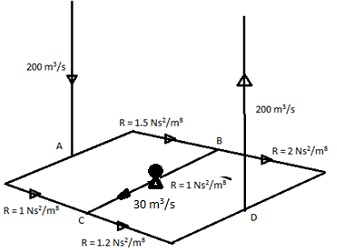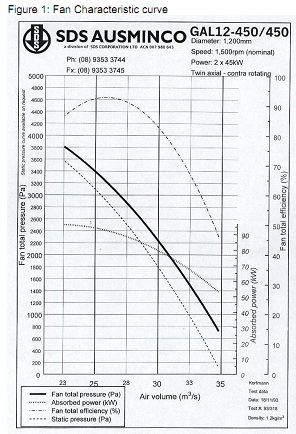Reference no: EM133122634
ENGIN3502 Subsurface Environmental Engineering - Federation University
Question 1: Two mine airways with resistances of 2 and 0.6 Ns2/m8 are connected together in parallel. Determine the resistance of the parallel combination. If 125 m3/s flows into this parallel combination of airways determine the flow in each airway.
Question 2: What is a Coward triangle?
Question 3: For the ventilation network shown below, determine the flow and pressure drop in each branch of the network. Ignore the shafts in your calculations.

Question 4: A section of a mine ventilation system is connected together as shown in the diagram overleaf, if the inflow into the system through the 1.2 Ns2/m8 airway is 400m3/s and the resistances are as indicated determine the flow in each airway.

Question 5: A mine has a total airflow requirement of 228m3/s. If the equivalent resistance of the workings is 0.35 Ns2/m8 determine the pressure to be developed by a single mine fan to ventilate the workings.
Question 6: A working area of a mine has diesel equipment operating within it. The maximum diesel loading is 750 kW. The same section of the mine also has a methane inflow of 0.25 m3/s flowing into it. If the maximum permissible methane concentration in the general body of the air is 0.5% and the design diesel air quantity is 5 m3/s per 100 kW of installed diesel power, determine the required ventilation flow rate for the working area.

Question 7: Determine the characteristic curves for the fan illustrated in figure 1 for the following cases:
• Two fans in series
• Three fans in parallel
• Four fans in a 2 x 2 series parallel combination
Question 8: A worker in a development drive is working at a rate of 250 W/m2. If the air velocity passing over the worker is 0.5 m/s, the air dry bulb temperature is 35°C, the air wet bulb temperature is 31°C, radiant temperature of the surroundings is 35°C, and it can be assumed that the worker's skin temperature is 34 °C, if the barometric pressure is 110 kPa determine:
• The air cooling power
• The basic effective temperature Is the environment safe to work in?
Question 9: During a 40h underground working week radiological monitoring indicates that a miner is subjected to the following levels and periods of exposure to radon daughters
20 h at 0.15 WL
10 h at 0.2 WL
10 h at 0.4 WL Determine the cumulative exposure in WLM for that week.
Question 10: In a given stope 450 m2 of ore and 150 m2 of waste rock surface are exposed. The stope also contains 3000 tonnes of broken ore. Assuming the ore has a density of 3000 kg/m3, determine the rate of emanation into the stope given the following:
J (ore) = 550 pCi/m2s B (ore) = 600 pCi/m3s J (waste) = 85 pCi/m2s
Question 11: The airflow is 50 m3/s in a 1500m long airway of perimeter 20m and cross sectional area 25 m2. If the initial concentration of radon in the airway is 25 pCi/l, there is an initial radon daughter activity of 0.05 WL at the entry and the rate of emanation J = 400 pCi/m2, determine the following:
• The working level of radon daughters at exit due to the initial radon
• The activity of radon daughters at outlet due to radon emitted from the rock surfaces
• The activity of radon daughters at outlet due to decay of radon daughter products available at entry
• The total working level of radon daughters leaving the airway
Question 12: Air enters an airway at the rate of 100 kg/s with a dry bulb temperature of 23 °C and a wet bulb temperature of 16 °C at a pressure of 100 kPa. This air flows along the airway initially picking up 400 kW of heat and 120 g/s of moisture from the surrounding strata. The air subsequently flows over a number of items of machinery where it is heated at constant moisture content to a dry bulb temperature of 32.5 °C.
Following the machinery the air is split into two distinct flows. Now 60 kg/s of the total flow passes through an air cooler in which the air-dry bulb temperature is cooled to 25°C with the wet bulb temperature reduced to 15 °C. The remainder of the flow is heated at a constant dry bulb temperature to an enthalpy of 72 kJ/kg. The two airflows are then recombined prior to the airflow being passed to another airway.
Using the psychrometric chart provided, calculate the following;
(a) The dry and wet bulb temperatures of the airstream immediately upstream of the machinery.
(b) The heat input from the machinery.
(c) The heat removed and the rate of condensation of water from the airstream passing through the air cooler.
(d) The wet bulb temperature of the airflow, which does not pass through the air cooler.
(e) The dry and wet bulb temperature of the recombined airstream at the exit of the airway.
Question 13. A moist airstream with a pressure of 100 kPa has an initial dry bulb of 27 °C and a wet bulb of 24 °C. Use the 100 kPa psychrometric chart provided to calculate the end dry/wet bulb to this original airstream when subjected to the following processes from the initial air state in each case:
(a) Heating at constant moisture content, raising the specific enthalpy by 8 kJ/kg.
(b) Enthalpy increase of 8 kJ/kg, moisture content increases to 19 g/kg.
(c) Constant dry bulb cooling to a moisture content of 0.01 kg/kg.
(d) Constant dry bulb heating to a relative humidity of 90 %.
(e) Constant wet bulb (and sigma heat) process to a relative humidity of 30 %.
(f) Constant wet bulb process to saturation.
(g) Constant moisture content process to saturation.
Question 14. The following two airstreams mix at the junctions of two roadways. The first airstream has a mass flow of 45 kg/s and a dry/wet bulb of 33/25 °C, the second airstream has a mass flow of 21 kg/s and a dry /wet bulb of 30/20 °C. The pressure is 100 kPa. Determine the dry/wet bulb temperatures of the mixed airstream.
Question 15. Describe the various methods of methane drainage available to drain gas for longwall mining operations.
Question 16. What methods are available to control dust in mines?
Question 17. What is dpm? What is nDPM? What limits exist in Australia in terms of worker exposure? Is there any safe exposure limit for either nDPM or DPM?
Question 18. What are the main sources of heat and humidity in mines? Briefly describe the methods that can be used to control heat and humidity in an underground mining situation.
Question 19. The conditions at the entrance to a crosscut are temperatures, 25°C wet bulb and 29°C dry bulb and barometric pressure 110 kPa. At the exit of the crosscut
the temperatures are 30°C wet bulb and 32°C dry bulb and the barometric pressure 110 kPa. The volume flow at the entrance is 34 m3/s. Determine;
• the water picked up in litres per day ,
• the heat picked up by the air in kW ,
• The increase in relative humidity.
Question 20. A mine has been sealed for some time following a fire. The atmosphere has stabilised and a typical analysis is
|
CO2
|
1.0%
|
CH4
|
3.7%
|
|
O2
|
17.1%
|
H2
|
0.0%
|
|
CO
|
0.03%
|
N2
|
78.2%
|
Determine
a. Graham's ratio and its implication
b. Trickett's ratio and its implication
Question 21. What systems are available for the ventilation of dead end drivages? For each system, sketch the system and detail particular advantages and disadvantages of the system.
Question 22. What are the advantages of siting main mine fans underground?
Question 23. For the fan curve for static pressure provided in Figure 1 determine the static pressure/quantity curve if the fan were working at 1300 rpm.
Attachment:- Subsurface Environmental Engineering.rar